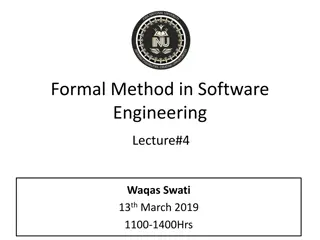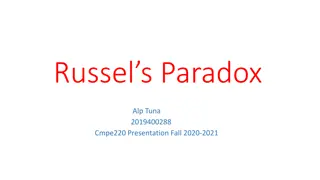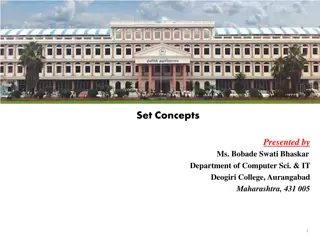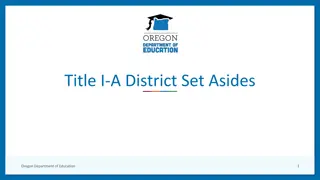
Key Events in U.S. History - Conflict and Compromise
Explore pivotal moments in U.S. history such as Bleeding Kansas, the Missouri Compromise, and the Compromise of 1850. Learn about the clashes between proslavery and antislavery groups, the resolution of conflicts between North and South, and the impact of key decisions on the nation's trajectory.
Download Presentation

Please find below an Image/Link to download the presentation.
The content on the website is provided AS IS for your information and personal use only. It may not be sold, licensed, or shared on other websites without obtaining consent from the author. If you encounter any issues during the download, it is possible that the publisher has removed the file from their server.
You are allowed to download the files provided on this website for personal or commercial use, subject to the condition that they are used lawfully. All files are the property of their respective owners.
The content on the website is provided AS IS for your information and personal use only. It may not be sold, licensed, or shared on other websites without obtaining consent from the author.
E N D
Presentation Transcript
In the 1850s, the phrase Bleeding Kansas was used to describe clashes between A. proslavery and antislavery groups B. Spanish landowners and new American settlers C. Chinese and Irish railroad workers D. Native American Indians and white settlers
Abolition, the Underground Railroad, and the Dred Scott decision would all be included in a discussion of A. federalism B. popular sovereignty C. states rights D. blockades
How did the Missouri Compromise resolve a conflict between the North and the South? A. It maintained a balance of slave and free states in the Senate. B. It maintained a balance of state representation in the House of Representatives. C. It brought an end to the Civil War. D. It established the Fugitive Slave Law.
A. It maintained a balance of slave and free states in the Senate.
People accused of being a fugitive slave could be held without an arrest warrant. They had no right to a trial by jury. Instead a federal commissioner ruled on each case. The commissioner received five dollars for releasing the defendant and ten dollars for turning the defendant over to the slaveholder. The scenario described above would apply to which of the following A. Kansas-Nebraska Act B. Missouri Compromise C. Compromise of 1850 D. Dred Scott v Sandford
In 1854, Stephen A. Douglas of Illinois drafted a bill to organize territorial government. He proposed that it be divided into two territories. To get southern support for the bill Douglas suggested the issue be settled by popular sovereignty. Even though the bill angered opponents of slavery it passed. The scenario above would apply to the following A. Dred Scott v Sandford B. Kansas-Nebraska Act C. Missouri Compromise D. Compromise of 1850
Which of the following was a result of the Compromise of 1850? A. Owning slaves was forbidden in Washington, D.C. B. Slavery was permitted in the new state of California. C. Importation of slaves from Africa was declared illegal. D. Runaway slaves had to be returned to Southern owners.
D. Runaway slaves had to be returned to Southern owners.
From 1820 to 1865, the debates over nullification, protective tariffs, and the spread of slavery into the new territories concerned the constitutional issue of the A. balance of power between the federal and state governments B. balance between the rights of individuals and the need to maintain order C. protection of the rights of ethnic and racial groups D. separation of power between the executive and legislative branches
A. balance of power between the federal and state governments
Which event was the immediate cause of the secession of several Southern states from the Union in 1860? A. the Dred Scott decision, which declared that all prior compromises on the extension of slavery into the territories were unconstitutional B. the Missouri Compromise, which kept an even balance between the number of free and slave states C. the raid on the Federal arsenal at Harper s Ferry, which was led by the militant abolitionist John Brown D. the election of President Abraham Lincoln, who opposed the spread of slavery into the territories
D. the election of President Abraham Lincoln, who opposed the spread of slavery into the territories
One impact of President Abraham Lincolns Emancipation Proclamation, on January1, 1863, was slavery would be illegal in the A. United States and the Confederacy B. United States, its territories, and the border states C. states or parts of states remaining in rebellion D. parts of the Confederacy then under federal control
An effect of the Confederate firing on Fort Sumter in 1861 was? A. The election of Abraham Lincoln. B. The declaration of the Emancipation Proclamation. C. The passing of the 13th, 14th, and 15th Amendments. D. The start of the Civil War.
General Lee surrendered at Appomattox Court House in Virginia. It was here where he launched an attack to break through the Union forces. What would you conclude was the overriding reason for his ultimate loss in this battle? A. The railroad carrying reinforcements was attacked further south B. The Confederate army was cut off by Sheridan s cavalry C. Lack of reliable intelligence about opposing strength D. The failure of the Union Calvary
C. Lack of reliable intelligence about opposing strength
In the United States, which situation that developed during the Civil War helped lead to the rapid development of big business? A. The large Southern factories that had competed with Northern factories were destroyed during the war. B. The Union government granted very large contracts for war supplies to Northern manufacturers. C. The government operated and consolidated most of the Northern manufacturing companies during the war. D. Northern business took over much of the European trade lost by the South due to the war.
B. The Union government granted very large contracts for war supplies to Northern manufacturers.
The slave rebellions like the one led by Nat Turner resulted in the passing of what policy? A. The Kansas-Nebraska Act B. Fugitive Slave Act C. Popular Sovereignty D. The Turner Slave Act
Between 1870 and 1900, the city became a symbol of a new America which attracted many people. Workers were drawn by economic opportunity and the promise of a more exciting life. Why was there an increase in the jobs available at factories in big cities? A. The people provided cheap labor with the many jobs available B. The businesses saw the need for additional regulations C. Businesses knew workers were going to have to come from somewhere D. The people were able to adapt to the ever- changing conditions of the cities
A. The people provided cheap labor with the many jobs available
Which of these documents established the principle of the United States as a federal union? A. the Declaration of Independence B. the Bill of Rights C. the Mayflower Compact D. the United States Constitution
The Articles of Confederation gave the government the power to A. allow states sovereignty B. appoint Supreme Court justices C. elect a federal leader D. regulate commerce
The 3rd Amendment to the Constitution of the U.S. states that, No Soldier shall, in time of peace be quartered in any house, without the consent of the Owner, nor in time of war, but in a manner to be prescribed by law. What brought about the need for this amendment according to the Founding Fathers? A. A prior King of England abused civil liberties of his subjects through the Quartering Act B. The perception that this type of quartering might happen with the new King in charge C. It was omitted in the Declaration of Independence D. Founders wanted to ensure the people had a designated right to prevent unreasonable searches
A. A prior King of England abused civil liberties of his subjects through the Quartering Act
Which possible way can the Executive Branch check the Judiciary Branch? A. Recess appointments B. Force adjournment C. Power to appoint judges D. Veto power
C. Power to appoint judges (The president appoints/chooses the new judges when one retires, or dies)
Why did writers of the U.S. Constitution ensure that there was a provision for limited government ? A. They felt that government should intervene to promote equality and opportunity B. Government should be in charge of regulation of property and wealth redistribution C. They held that the government should have unlimited sovereignty over its subjects D. They patterned it after the Magna Carta which stood as an exemplar of a document limiting sovereignty
D. They patterned it after the Magna Carta which stood as an exemplar of a document limiting sovereignty
After the Election of 1800 it was decided that candidates would run specifically for the office of Vice-President. This change in the U.S. Constitution was accomplished by the A. 12th Amendment B. 13th Amendment C. 18th Amendment D. 19th Amendment
Which event caused anti-British feelings? A. Boston Tea Party B. Boston Massacre C. Continental Congress D. Boycott of British goods
As a result of President Andrew Jacksons policies, Native American Indians were A. relocated to reservations in Mexico B. forcibly removed to areas west of the Mississippi River C. gradually allowed to return to their ancestral lands D. given United States citizenship
B. forcibly removed to areas west of the Mississippi River






















